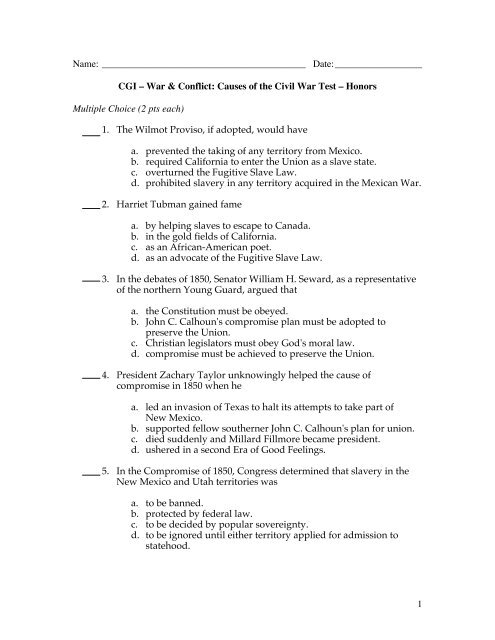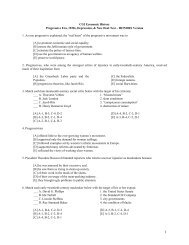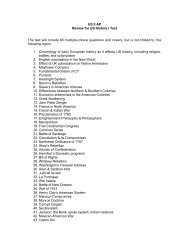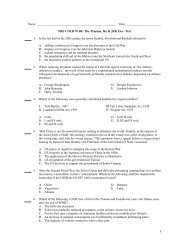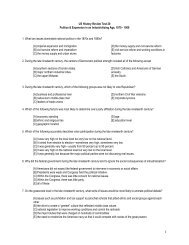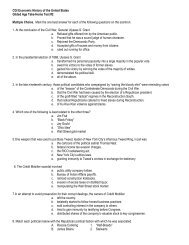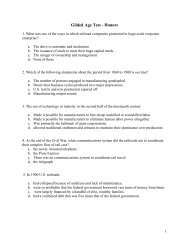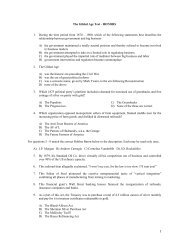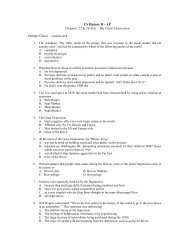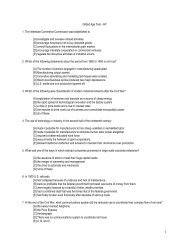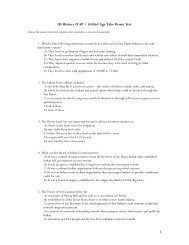CGI – War & Conflict - Mr. Manos
CGI – War & Conflict - Mr. Manos
CGI – War & Conflict - Mr. Manos
Create successful ePaper yourself
Turn your PDF publications into a flip-book with our unique Google optimized e-Paper software.
Name: __________________________________________ Date:__________________<br />
<strong>CGI</strong> <strong>–</strong> <strong>War</strong> & <strong>Conflict</strong>: Causes of the Civil <strong>War</strong> Test <strong>–</strong> Honors<br />
Multiple Choice (2 pts each)<br />
1. The Wilmot Proviso, if adopted, would have<br />
a. prevented the taking of any territory from Mexico.<br />
b. required California to enter the Union as a slave state.<br />
c. overturned the Fugitive Slave Law.<br />
d. prohibited slavery in any territory acquired in the Mexican <strong>War</strong>.<br />
2. Harriet Tubman gained fame<br />
a. by helping slaves to escape to Canada.<br />
b. in the gold fields of California.<br />
c. as an African-American poet.<br />
d. as an advocate of the Fugitive Slave Law.<br />
3. In the debates of 1850, Senator William H. Seward, as a representative<br />
of the northern Young Guard, argued that<br />
a. the Constitution must be obeyed.<br />
b. John C. Calhoun's compromise plan must be adopted to<br />
preserve the Union.<br />
c. Christian legislators must obey God's moral law.<br />
d. compromise must be achieved to preserve the Union.<br />
4. President Zachary Taylor unknowingly helped the cause of<br />
compromise in 1850 when he<br />
a. led an invasion of Texas to halt its attempts to take part of<br />
New Mexico.<br />
b. supported fellow southerner John C. Calhoun's plan for union.<br />
c. died suddenly and Millard Fillmore became president.<br />
d. ushered in a second Era of Good Feelings.<br />
5. In the Compromise of 1850, Congress determined that slavery in the<br />
New Mexico and Utah territories was<br />
a. to be banned.<br />
b. protected by federal law.<br />
c. to be decided by popular sovereignty.<br />
d. to be ignored until either territory applied for admission to<br />
statehood.<br />
1
6. The most alarming aspect of the Compromise of 1850 to northerners<br />
was the decision concerning<br />
a. slavery in the District of Columbia.<br />
b. slavery in the New Mexico and Utah territories.<br />
c. the new Fugitive Slave Law.<br />
d. settlement of the Texas-New Mexico boundary dispute.<br />
7. The Fugitive Slave Law included all of the following provisions<br />
except<br />
a. the requirement that fugitive slaves be returned from Canada.<br />
b. denial of a jury trial to runaway slaves.<br />
c. denial of fleeing slaves' right to testify on their own behalf.<br />
d. the penalty of imprisonment for northerners who helped<br />
slaves to escape.<br />
8. Many northern states passed "personal liberty laws" in response to<br />
the Compromise of 1850's decision on<br />
a. slavery in the District of Columbia.<br />
b. slavery in the territories.<br />
c. runaway slaves.<br />
d. the interstate slave trade.<br />
9. The prime objective of Manifest Destiny in the 1850s was<br />
a. Panama.<br />
b. Nicaragua.<br />
c. Cuba.<br />
d. California.<br />
10. The most brazen scheme for territorial expansion in the 1850s was<br />
expressed in the<br />
a. Clayton-Bulwer Treaty.<br />
b. Wilmot Proviso.<br />
c. Ostend Manifesto.<br />
d. Gadsden Purchase.<br />
11. Stephen A. Douglas proposed that the question of slavery in the<br />
Kansas-Nebraska Territory be decided by<br />
a. popular sovereignty.<br />
b. making Kansas a free territory and Nebraska a slave territory.<br />
c. the Supreme Court.<br />
d. admitting both California and Kansas-Nebraska to the Union.<br />
2
12. Stephen A. Douglas's plans for deciding the slavery question in the<br />
Kansas-Nebraska Bill required repeal of the<br />
a. Compromise of 1850.<br />
b. Missouri Compromise.<br />
c. Wilmot Proviso.<br />
d. Northwest Ordinance.<br />
13. Uncle Tom's Cabin may be described as<br />
a. a firsthand account of slavery.<br />
b. a success only in the United States.<br />
c. a powerful political force.<br />
d. having little effect on the start of the Civil <strong>War</strong>.<br />
14. As a result of reading Uncle Tom's Cabin, many northerners<br />
a. found the book's portrayal of slavery too extreme.<br />
b. vowed to halt British and French efforts to help the<br />
Confederacy.<br />
c. rejected Hinton Helper's picture of the South and slavery.<br />
d. swore that they would have nothing to do with the<br />
enforcement of the Fugitive Slave Law.<br />
15. Hinton R. Helper's book The Impending Crisis of the South argued that<br />
those who suffered most from the use of slave labor were<br />
a. nonslaveholding southern whites.<br />
b. southern planters.<br />
c. northern Republican abolitionists.<br />
d. western farmers.<br />
16. In "Bleeding Kansas" in the mid-1850s, __________ was/were<br />
identified with the proslavery element, and __________ was/were<br />
associated with the antislavery free soilers.<br />
a. Beecher's Bibles; border ruffians<br />
b. John Brown; Preston Brooks<br />
c. the Pottawatomie massacre; the sack of Lawrence<br />
d. the Lecompton Constitution; the New England Immigrant Aid<br />
Society<br />
17. In 1856, the breaking point over slavery in Kansas came with<br />
a. the arrival of John Brown.<br />
b. an attack on Lawrence by a gang of proslavery raiders.<br />
c. the influx of a large number of slaves.<br />
d. none of these.<br />
3
18. The Lecompton Constitution proposed that the state of Kansas<br />
a. be free of all slavery.<br />
b. have black bondage regardless of whether the document was<br />
approved or not.<br />
c. be controlled by the free-soilers if approved.<br />
d. allow slavery but prohibit slave auctions.<br />
19. The situation in Kansas in the mid-1850s indicated the impracticality<br />
of __________ in the territories.<br />
a. abolitionism<br />
b. free soil<br />
c. popular sovereignty<br />
d. slavery<br />
20. Which party is correctly matched with its platform?<br />
a. Republicans & popular sovereignty.<br />
b. Know-Nothings & nativism.<br />
c. Constitutional Union & high tariffs.<br />
d. Democrats & abolitionism.<br />
21. Know-Nothings in the 1850s were known for their<br />
a. support of Native Americans (Indians).<br />
b. support of slavery.<br />
c. opposition to old-stock Protestants.<br />
d. anti-Catholic and anti-foreign attitudes.<br />
22. Stephen A. Douglas argued in his Freeport Doctrine during the<br />
Lincoln-Douglas debates that<br />
a. the Dred Scott decision was unconstitutional.<br />
b. action by territorial legislatures could keep slavery out of the<br />
territories.<br />
c. popular sovereignty would guarantee slavery in all United<br />
States territories.<br />
d. Congress should reopen the Atlantic slave trade.<br />
23. The presidential candidate of the new Constitutional Union party in<br />
1860 was<br />
a. Stephen A. Douglas.<br />
b. John Breckenridge.<br />
c. John Bell.<br />
d. Jefferson Davis.<br />
4
24. Abraham Lincoln opposed the Crittenden Compromise because<br />
a. it allowed the doctrine of popular sovereignty to be overrode<br />
once statehood was achieved.<br />
b. he opposed the expansion of slavery in the territories.<br />
c. its adoption might provoke Kentucky to leave the Union.<br />
d. he felt bound by President Buchanan's earlier rejection of it.<br />
25. The proposed Crittenden Compromise, if adopted, would have<br />
a. allowed slavery north of 36¯ 30'.<br />
b. guaranteed federal protection of slavery in territories south of<br />
36¯ 30'.<br />
c. annexed Cuba as a slave territory of the United States.<br />
d. repealed the Fugitive Slave Law.<br />
Matching: Print the corresponding CAPITAL Letter in the space provided (2 pt.s ea.)<br />
______1. plotted revolt in Richmond & was killed A. Abraham Lincoln<br />
______2. planned the1822 foiled revolt in Charlestown B. Nat Turner<br />
______3. leader of the bloodiest slave revolt in US C. John Quincy Adams<br />
______4. waged an 8 year campaign against Gag Rule D. Charles Sumner<br />
______5. wrote South Carolina Exposition & Protest E. Andrew Butler<br />
______6. argued States’ Rights in Webster/Hayne Debate F. Andrew Jackson<br />
______7. argued Nationalism in Webster/Hayne Debate G. John C. Calhoun<br />
______8. Senator who got the 1850 Compromise passed H. Henry Clay<br />
______9. he was attacked in the Bully Brooks incident I. Gabriel Prosser<br />
______10. won the election of 1856 J. James Buchanan<br />
K. Stephen Douglas<br />
L. Daniel Webster<br />
M. Robert Hayne<br />
N. Denmark Vesey<br />
5
Multiple Choice (2 pts each)<br />
Civil <strong>War</strong> & Indian <strong>War</strong>s Test <strong>–</strong> Honors<br />
1. The battle of Vicksburg is a significant victory in that<br />
A. the Union, under Grant, gained control of the Mississippi River<br />
B. the Confederacy<br />
C. declared martial law where needed<br />
D. never had to use troops<br />
2. During the Civil <strong>War</strong>, most of the Five Civilized Tribes in the Indian Territory of<br />
present day Oklahoma<br />
A. supported the Union<br />
B. remained neutral<br />
C. supported the Confederacy<br />
D. gave up their slaves<br />
3. As the Civil <strong>War</strong> began, the South seemed to have the advantage of<br />
A. the ability to wage offensive warfare<br />
B. superior industrial capabilities<br />
C. many talented military leaders<br />
D. superior transportation facilities<br />
4. It is often stated that the Civil <strong>War</strong> was over before it started. Which of the<br />
following lends credence to this theory?<br />
A. The Union’s lack of men of combat age: only 1.2 million as compared to the<br />
South’s 4 million<br />
B. The lack of railroads, equipment and factories in the Union<br />
C. The Union’s ability to out-produce the Confederacy in virtually all<br />
agricultural goods except cotton<br />
D. The overwhelming amount of the nation’s deposits held by Confederate banks<br />
5. Northern soldiers eventually became known for their<br />
A. discipline and determinantion<br />
B. cowardice in battle<br />
C. lack of proper training<br />
D. high pitched battle yell, which sounded much like the Buffalo<br />
6
6. To find effective high level commanders, the Union<br />
A. took only top graduates from West Point<br />
B. used the trial and error method<br />
C. relied on the advice of foreign experts<br />
D. did not let politics enter the decision-making process<br />
7. The Battle of Shiloh<br />
A. was another victory for the South in the Eastern theater<br />
B. took more American lives than all previous US wars combined<br />
C. was a near defeat for the Confederacy before reinforcements arrived<br />
D. all of the above<br />
E. none of the above<br />
8. The North’s greatest strength in the Civil <strong>War</strong> was its<br />
A. navy<br />
B. military leadership<br />
C. high morale<br />
D. economy<br />
9. Border States that remained loyal to the Union included<br />
A. Kentucky<br />
B. Maryland<br />
C. Missouri<br />
D. All of the above<br />
E. None of the above<br />
10. Who was exempted from conscription during the Civil <strong>War</strong>?<br />
A. northerners who paid the government or a substitute $300 and southerners<br />
who owned at least twenty slaves<br />
B. northerners who had a widowed mother to support and southerners who<br />
owned no slaves<br />
C. northerners and southerners who could not afford the $300 conscription fee<br />
D. northerners and southerners who objected to war on moral grounds<br />
11. The purpose of the Anaconda Plan was to<br />
A. seal off the Confederacy along the Mississippi and the coast through blockade<br />
B. elect McClellan, nicknamed Anaconda, as President in 1864<br />
C. seal off the Union along the Ohio River and the Atlantic coast<br />
D. infiltrate the South in a “snake-like” fashion and incite antisecession sentiment<br />
E. secretly reunite J Lo and Ice Cube one more time in hopes of box office glory<br />
7
12. The Battle of Antietam in September 1862<br />
A. was a strategic victory for the North due in large part to the Union’s discovery<br />
of Robert E. Lee’s battle plans<br />
B. encouraged Lincoln to issue the Emancipation Proclamation<br />
C. made it increasingly less likely that the Confederacy would gain the<br />
recognition of Britain & France as an independent nation<br />
D. all of the above<br />
E. none of the above<br />
13. The Confederacy failed to receive diplomatic recognition by England or France<br />
for all of the following factors except<br />
A. Lincoln’s Emancipation Proclamation, which dampened Europe’s enthusiasm<br />
for Confederate recognition<br />
B. The British awareness that their true diplomatic interest lay in supporting the<br />
Union blockade, as they may want to use similar tactics in a future war<br />
C. The skillful diplomacy of the Union, which avoided diplomatic conflicts and<br />
tension with both England and France<br />
D. England’s alternative sources of cotton<br />
14. The most important factor in Abraham Lincoln’s 1864 reelection victory was<br />
A. his furlough of Union soldiers so that they could vote for him<br />
B. the fall of Atlanta and Mobile to Union forces in September1864<br />
C. the lack of any organized political opposition<br />
D. the split between Lincoln & Radical Republicans over plans for reconstruction<br />
15. Which group of battles is correctly identified as Union or Confederate victories?<br />
A. Confederate victories: Chancellorsville, Chiamauga & Antietam<br />
B. Union victories: Antietam, Gettsburg & Vicksburg<br />
C. Confederate victories: Shiloh, New Orleans & Fredericksburg<br />
D. Union victories: Vicksburg, Shiloh and Chickamauga<br />
16. During the Civil <strong>War</strong><br />
A. African-Americans were enlisted by the Union army only after the<br />
Emancipation Proclamation was issued<br />
B. Southern armies found no way of utilizing slave labor<br />
C. Thousands of slaves rose in armed rebellion behind Southern lines<br />
D. About one out of every four Union troops was African-American<br />
8
17. The Battle of Gettysburg was significant because<br />
A. The war ended shortly thereafter<br />
B. Union victory, the final turning point, meant that the South was doomed<br />
C. The Union had uncovered Confederate battle plans wrapped around cigars<br />
D. It was decided so quickly<br />
18. Clement L. Vallandigham, a Southern sympathizer and vocal opponent of the war,<br />
was derisively labeled a<br />
A. Carpetbagger<br />
B. Contraband<br />
C. Copperhead<br />
D. Plug-Ugly<br />
19. Among the casualties of the Civil <strong>War</strong> were<br />
A. slavery<br />
B. presidential power<br />
C. states’ rights<br />
D. all of the above<br />
E. both A and C are correct<br />
20. Which person is correctly paired with his plan or technique for military victory?<br />
A. McClellan: surround the Confederacy and choke it into submission<br />
B. Winfield Scott: simultaneous, coordinated attacks on several fronts<br />
C. Lincoln: a bloodless defeat followed by a negotiated peace that would leave<br />
slavery intact<br />
D. Sherman: “total war”<br />
21. In post-Civil <strong>War</strong> America, Indians surrendered their lands only when they<br />
A. Chose to migrate further west<br />
B. Received solemn promises from the government that they would be left alone<br />
and provided with supplies<br />
C. Lost their mobility as the whites killed their horses<br />
D. Were allowed to control the supply of food and other staples to the<br />
reservations<br />
22. The Indians battled whites for all of the following reasons except to<br />
A. Rescue their women who had been exiled to Florida<br />
B. Avenge savage massacres of Indians by whites<br />
C. Punish whites for breaking treaties<br />
D. Defend their lands against whites<br />
23. As a result of the defeat of Captain William Fetterman’s command,<br />
A. The government built new forts on the Bozeman Trail<br />
B. The Great Sioux Reservation was guaranteed to the Sioux tribes<br />
C. The Bozeman Trail was reopened<br />
D. White settlers abandoned the Dakota Territory<br />
9
24. The Plains Indians were nearly exterminated<br />
A. By their constant intertribal warfare<br />
B. When they settled on reservations<br />
C. After such famous leaders as Geronimo and Sitting Bull were killed<br />
D. By virtual extermination of the buffalo<br />
25. The Nez Perce Indians of Idaho were goaded into war when<br />
A. The Sioux sought their land<br />
B. Gold was discovered on their reservation<br />
C. The federal government attempted to put them on a reservation<br />
D. The Canadian government attempted to force their return to the US<br />
26. The buffalo were nearly exterminated<br />
A. As a result of being overhunted by the Indians<br />
B. By trains racing across the Great Plains<br />
C. Through wholesale butchery by whites<br />
D. By disease<br />
27. A Century of Dishonor (1881), which chronicled the dismal history of Indianwhite<br />
relations, was authored by<br />
A. Harriet Beecher Stowe<br />
B. Helen Hunt Jackson<br />
C. Chief Joseph<br />
D. Joseph F. Glidden<br />
28. The humanitarians who wanted to treat the Indians kindly<br />
A. Had little respect for traditional Indian culture<br />
B. Advocated allowing the Ghost Dance to continue<br />
C. Opposed passage of the Dawes Act<br />
D. Believed that Indians should not be forced to “walk the white man’s way”<br />
29. To assimilate into American society, the Dawes Act did all of the following<br />
except<br />
A. Dissolve many tribes as legal entities<br />
B. Try to make rugged individualists of the Indians<br />
C. Wipe out tribal ownership of land<br />
D. Outlaw the sacred Sun Dance<br />
30. The US government’s outlawing of the Indian Ghost Dance in 1890 resulted in<br />
the<br />
A. Battle of Wounded Knee<br />
B. Sand Creek Massacre<br />
C. Battle of Little Big Horn<br />
D. Dawes Severalty Act<br />
10


